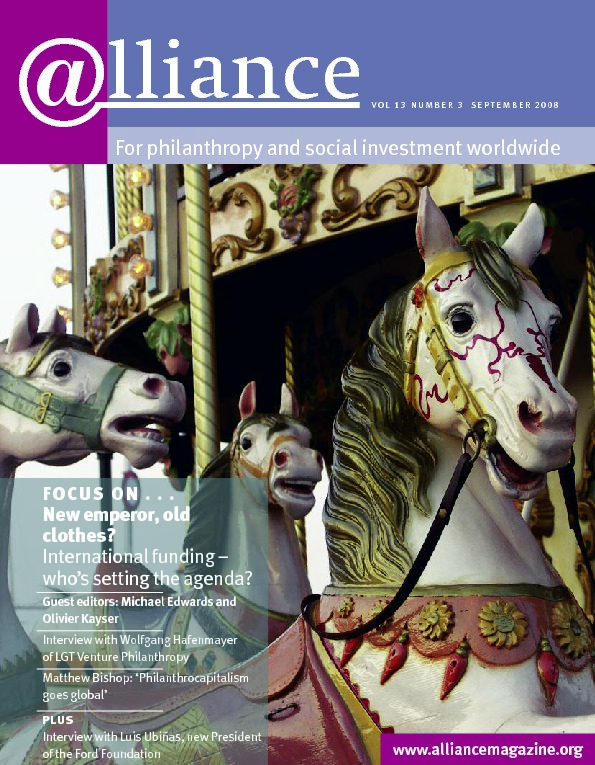 How can non-profit organizations build on their successful projects? And how can foundations help them to do this? Replication is one approach, but propagation is a more robust concept.
How can non-profit organizations build on their successful projects? And how can foundations help them to do this? Replication is one approach, but propagation is a more robust concept.
While both terms imply the continuation and growth of successful projects, propagation encompasses a broader array of results, successive ‘generations’ and new directions. Propagation embodies the spread and adaptation of ideas and projects into new geographical, cultural and socioeconomic settings.
One strategy for expanding or ‘scaling up’ successful projects is to help them ‘replicate’, that is, to copy their essential features and implement them in other settings. However, the term replication is lifted from two other contexts: (a) the laboratory experiment (a scientist wants to replicate an experiment in order to confirm a hypothesis) and (b) the world of retail licences and franchises (McDonalds wants to offer consistency of food, value and ‘customer experience’ in its locations). Neither use of the term is usually applicable to social services or community-based organizations.
A successful community-based project ordinarily cannot be copied, ‘cloned’ or franchised. The driving factors for success are almost always idiosyncratic, often dependent on the efforts of one or more ‘champions’, and closely linked to the particular circumstances of time and place. An evaluation of a purported ‘success’ frequently identifies – and then stumbles over – salient variables that differ from one setting to another. The resulting comparison of ‘apples and oranges’is misleading or inconclusive.
Another weakness is an over-emphasis on developing ‘best practice’. There is a view that a few processes or techniques that worked successfully in one setting can be disseminated in an almost uniform and self-contained package, a view that often underestimates or ignores the complex human, organizational and other context-specific issues.
Propagation – adaptation, dispersal and expansion
A more modest, realistic and robust concept is propagation, a natural science term that suggests dispersal and expansion in numbers. It also conveys the inherent nature of multiple generations and the existence of variability among individual cases. Propagation is successful in the same way as families – having children and grandchildren that carry on many features of their ancestors but are visibly quite different. It is therefore a more useful concept and a more achievable objective than replication.
However, while many organizations have the capability to maintain and manage a project, most are concerned with immediate priorities and lack the capability to expand programmes or improve them in an organized way. A corollary is that few organizations have developed the explicit capacity to propagate. ‘Success stories’ are readily publicized, but how many organizations can repeatedly accommodate a visiting intern or middle manager to learn the specifics? How often does the founder/champion spend an extended period of time at another site as mentor or evangelist? To what extent is there any ongoing process of nurturing the spawn or even defining propagation as an important goal of an organization? Seldom is there any recognition that the organization itself must devote resources of time, energy and money, and evolve operating procedures that foster propagation. This is where grantmakers can help – not only with money but also with a broader and more informed view of the process itself.
Benefits of the propagation approach
There are benefits to funders, to grantees, and to the target populations from adopting the propagation approach.
- Increased impact Grantmakers should pay more attention to ‘success stories’. Start-ups and projects that respond to compelling needs deserve philanthropic support. Our point is not to denigrate those efforts, but rather to include propagation as another recognized objective. It addresses the question: ‘Is money well spent?’ Part of the answer may be to target projects that have already succeeded and help them propagate.
- Critical elements Propagation recognizes that successful organizations depend on the devoted efforts and specific human ‘touch’ of the people who made it happen. Grants targeted at propagation can support key individuals financially as well as the ideas that have been successful. Resources must be expended on nurturing new generations over a long time period – beyond short-term calculations of ‘cost-effectiveness’. This is an important perspective that foundation funding can provide.
- Organizational effectiveness Propagation grants offer a tangible incentive and reward for success. They reinforce what the organization is doing well, and strengthen communication between board and staff as they focus on priorities both in and outside the organization.
- Human capital A less obvious and longer-term impact of propagation is to build a genuine career path for the champions within (or outside) the organization, and a correspondingly lessened risk of ‘burn-out’, or leaving the field.
- Low risk and high efficiency In short, propagation is a comparatively low-cost method of spreading good ideas into new settings. In effect, grants for propagation provide social venture capital and liquidity to fund a start-up in a new setting without reinventing the wheel.
Critical financial and staffing issues
There are some clear financial and staffing implications for organizations interested in propagation:
- It needs an explicit allocation of staff time in order to be successful, so it will be necessary to ‘buy off’ some percentage of the time of key individuals who led a successful project – say 10-25 per cent, to be spent in mentoring interns from other organizations, attending conferences, publishing reports, etc.
- The board and top management must decide to include propagation in the strategy and objectives of the organization and communicate the fact and its implications clearly to stakeholders inside and outside the organization.
- Appropriate criteria are needed to monitor and assess propagation. Many of its benefits accrue outside the organization and it is important to weigh its value to the ongoing success of the organization through other financial, operational and non-tangible criteria.
- Propagation invites collaboration with others. Because of the external and long-term impacts, there are opportunities to develop alliances and collaborations and to offset some of the costs.
In short, propagation means refocusing within the organization in order to build on success, and this will have implications for every part of the organization. However, I believe that it is a more robust and realistic concept than replication. In financial terms, a comparatively modest outlay can deliver considerable impact by helping to make it possible for successful projects to continue, to be adapted to new settings, and to be communicated more widely.
James R Posner, PhD, is Chair of the US-based Posner-Wallace Foundation. Email Posnerplus@AOL.com
 Comment Geoff Mulgan
Comment Geoff Mulgan
James Posner’s piece is a useful corrective to some of the less considered discussions of scaling up and replication. These latter metaphors come from manufacturing, where the same thing can be multiplied infinitely without it changing. Some of them are attractive because anyone involved in social change naturally wants their model to have the maximum possible impact in meeting needs.
Equally they want to achieve a fair return for their work, which is why there has been so much interest in adapting intellectual property models from business, and turning social ventures into franchises or licences. Add to that mix the assumption of many in the venture philanthropy field that there is no fundamental difference between scaling up a technology company and scaling up a programme for the homeless, and it’s not surprising that this language has become ubiquitous.
There have been some examples of success in scaling up, where the same model has spread to many countries and communities without changing much. A good contemporary example might be nurse/family partnerships. But there are far fewer successful examples than one might expect from the rhetoric around social entrepreneurship and NGO management. Indeed, almost without exception the truly transformative ideas – from low-carbon living to disability rights, microcredit to zero waste – have spread in much more complicated and messy ways.
There are many reasons for this. Some have to do with lack of access to capital and skills. Some have to do with the fact that growth usually requires changes of form: NGOs can rarely grow without changing their leadership, aspects of their culture, their stakeholders and their internal systems. Some of the reasons have to do with culture: an idea may work brilliantly in Atlanta but prove wholly unsuitable in Athens.
It is also inherently hard to scale up services that are about care and love: by their nature these are human scale and collapse when they are organized at an industrial scale. James Posner is right that the language of propagation fits better with the mindset of most social innovators and activists, who are more concerned to see their idea spread than to control its precise form.
But propagation is itself often too narrow a metaphor. Some patterns of growth involve grafting – a new idea is grafted on to existing organizations. Others diffuse. Nor is it enough simply to devote resources to propagation. Our work on the growth of innovations emphasizes the need to link what we call effective supply (turning the model into something truly robust) and effective demand (finding someone willing to pay for it). In some cases the priority is advocacy to promote demand, persuading people that there’s a need for the idea in the first place; in others, where demand is already there, it’s enough to promote and propagate.
So yes, let’s not get too stuck on inappropriate concepts of scaling up and replication. But let’s also find a wider set of metaphors and concepts to fit the complexities of social change.
Geoff Mulgan is Director of the Young Foundation. Email geoff.mulgan@youngfoundation.org



Comments (0)